|
The Dhahran to Al Khobar road of the late nineteen forties was sandy, rocky, and partially surfaced with oil . It passed by the Arab police station, Saudi camp, the U. S. Consulate, the hobby farm, emhoff gardens, Dhahran Rolling Hills golf course, the airport, and the Thuqba turnoff. The seven kilometer trip was basically a downhill ride. Otherwise, the ground was sandy and rock-strewn, with several automobile wrecks along the way. The Bedouin custom of leaving unattended personal property undisturbed was about to be modernized. ARAMCO's transportation department ran a bus schedule to al Khobar for years. The buses were big, red diesel Kenworths. Passengers sat up high and could see quite well. They were not air conditioned. The schedule was sensitive to prayer time and brought visitors at appropriate intervals. The service was free to senior staff and their dependents. The police station was on the south side as the road curled off the jebel heading east. At odd times, I noticed some sort of pole structure out front; it was ‘T' shaped near the top and little brown or black things were spaced along the limbs of the ‘T ,' hanging from short ropes. They turned, twisted, and bumped together in the breeze or wind. There were different numbers, sometimes two or three of these little things. I was just eleven and it never occurred to me that these things were human hands or feet! The day I realized what they were was very sobering. Once, near the police station, our bus was soundly stoned by a small group of Arab children. The bus was at full tilt and I watched one boy fling a rock at us; it seemed as though the rock would go ahead of us but as the bus sped along the rock scribed an arc which splattered against a window near mine. It crashed with a loud report and everybody slumped down in their seats. That was the first time I realized that someone is Saudi Arabia did not like Americans. The second time was when we got off a bus in Hofuf; there, someone spit on the back of my neck. Continuing down the road, Saudi camp was on the north side. Arabs would stream home afoot, on bikes, or on buses. Many set out a cloth before their apartment doorways and display items for sale, everything from watches to Dinky Toys. The Saudi camp mosque was the most beautiful structure in the area, sandy-white with tall, twin minarets. The muezzin would climb to the top and call the prayer. Later a loudspeaker replaced the need to climb. |
|||||||||||||||||||||
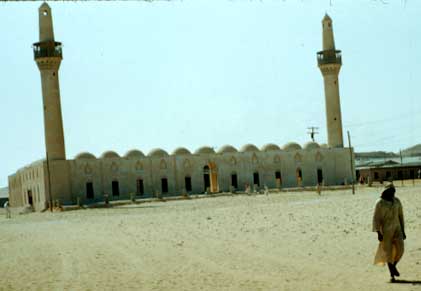 |
|||||||||||||||||||||
| This Mosque was an early addition to Saudi camp. Camp barracks can be seen in the right background. (rcc) | |||||||||||||||||||||
|
A few crafts people made footwear in Saudi camp. I probably bought a dozen pairs of sandals over the years. You could go down one day, get measured, then go back several days later and pick up your custom ware. They would measure your foot by using one hand with fingers stretched wide, using the thumb tip to little finger tip span, and then use the fingers of the other hand held together (parallel). Your length might be a span plus two finger widths. Once you had the sandals, which seldom cost more than ten Saudi Riyals (SR10), you took them home and soaked them with the hose. Then you sat for a time while the softened leather snuggled up to your feet. Colored leather, which was the best tanned quality, and thin leather soles were the more expensive sandals. We used to count the number of leather knots on the crossover strap to brag about the quality of our sandals. Most sandals had three of four knots. After a few years, the crafts people began to use the sides and bottoms of castoff rubber tires to make sandal soles. These wore like iron but were worn only by laborers and a few Americans who thought them novel. The best pair of sandals I ever saw were made in Hofuf and belonged to Steve Furman. They had hand tooled designs on the broad, side flap. Next on the south side came the U.S. Consulate. It was very small in the beginning and Americans were put out that the Saudi government would not allow the flag pole to touch their soil. It was therefore set above ground. The emhoff gardens came up next on the north side of the road. It contained the ARAMCO sewer department. It was sequestered by trees--quite healthy looking trees. |
|||||||||||||||||||||
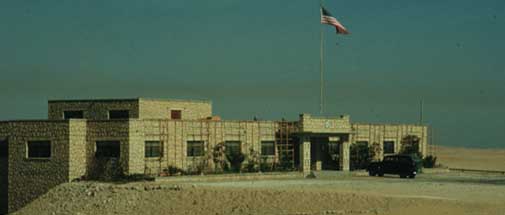 |
|||||||||||||||||||||
| The United States Consulate at Dhahran. Note the position of the Stars and Stripes. (rcc) | |||||||||||||||||||||
|
Next to the gardens was the hobby farm. It was a popular place. I was told Steve Furman's dad started the farm as a food source. Several ARAMCO people owned horses that were stabled there. These Arabians were the most beautiful I have ever seen. They had small heads, short, powerful necks, and huge hindquarters. They were spirited with the desire to run. The farm's elder resident was Humdoni. He was a big, old, gentle, dapple-gray stallion. Just right for me. Ubayn was a rascal; as soon as you got near him, he would measure you into a false sense of security and then step on your foot. This failing, he tried to nip, and if that didn’t succeed, he lashed out with a front foot. Layla and Cullie were gentle mares. They were red and would run until their wind gave out. The farm also had lizards, chickens, gazelles, and on occasion, an oryx. They had slightly curved horns and their necks were all powerful. We used to feed them cigarettes through the fence. I reached in one time and grasped a horn. The oryx nodded his head and almost broke my arm! The kids loved to tease him because he would draw back and blast the fence in a ramming motion. The hobby farm was a big success. From its meager beginnings on the al Khobar road, the hobby farm is now within the camp fence, not too far from the reclamation yard. The Dhahran Rolling Hills golf course was Dad’s favorite hangout, the movie theater excepted. I liked to play and usually did this with friends like Bob Hardy. Once or twice we rode our bikes down there; the trip back was a battle, all up hill and sometimes through heavy sand furrows created by the last shamaal. The greens were oil and sand mix and there were laborers who dragged each green after the players finished that hole. Some of the players carried a ‘T’ shaped bar used to smooth a path to the hole once the ball was on the green. Arabs caddied and they had great eyes to track the flight of the ball, which was painted with stripes or dyed red. We carried our own water in the beginning but eventually water containers were at each hole. Currently that nine hole course is 27 holes and occupies a large piece of real estate south of the old camp. The new camp, Dhahran Hills, is just beyond the golf course. A four mile walking path nearly surrounds the new golf course. It even has a water hole! The Dhahran airport was the exclusive property of ARAMCO for a while. They put up a huge hanger and operated Navions, DC-3s, DC-4s, DC-6s, and a host of other aircraft from this facility. Huge contracts were let to Fluor and other companies to create a major facility but this came a little at a time. In the early years, Super Constellations of TWA, KLM, and PAN AM, all used the same roll-up passenger staircase. Dhahran was truly the end of the line for a while. It is still very remote. |
|||||||||||||||||||||
 |
 |
Two Connies at the Dhahran Airfield. PAN AM and KLM were just two major airlines to service ARAMCO's needs despite the fact that ARAMCO owned the eleventh largest private airline in the mid-1950s. Note the ARAMCO hangers in the background of the lower photo. TWA was the other regular visitor with Connies. ARAMCONS were frequently seeing friends off or picking them up. (rcc) | |||||||||||||||||||
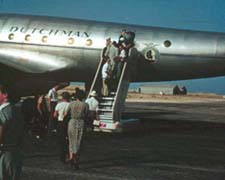 |
|||||||||||||||||||||
| ARAMCO Navion. Dad called these the Cadillac of light airplanes. He mentioned being on several flights up the TAP line. Cathodic protection equipment was run by diesel engines along the pipeline and a flag was attached to a cap on the exhaust pipe. If the engine was not running, there would be no exhaust and the flag would be down, an easy indicator for a low-flying pilot to spot and report. (rcc) | |||||||||||||||||||||
| On the outskirts of al Khobar, the Thuqba turn out led south to al Azzaziyah beach and spit. There was always a sprinkling of barasti shelters there. Most of these were not weatherproof. One or two had barasti fences to define some property line. The main road continued toward the Eastern Star Hotel; the marketplace, which functioned one day a week, was on a flat piece of ground about half a kilo from the beach, depending on the tide. Conditions were unsanitary; flies were everywhere since al Khobar had no plumbing or sewer system. This has changed dramatically. Within a short time, after 1949, shops began to spring up. ARAMCO had many household workers, some from India and Goa, and of course many new Saudi workers. These jobs put millions of Riyals' worth of hard currency into the Eastern province's economy. A few of these people had alternative skills such as bicycle repair, tailoring, and precious metals working. They started businesses within their own houses but some took Saudi partners and expanded downtown. The main street became longer and more defined as permanent structures multiplied. By 1953, Al Khobar was really on the map. If there was an American desire for a specific product, retail merchants made sure they stocked these items regularly. One could purchase the best camera equipment, Rolex and Omega watches, all exotic gems and jewelry, carved brass and copper, leather goods of Middle East flavor, tailored clothing, canned foods, Ray Ban sunglasses, English and Italian shoes, pearls from the Gulf, furnishings, carved wood, and French garments and perfume. A coffee house began and the old Saudis used to sit in the shade and puff their hubbly-bubblies while Westerners took home everything from rugs to coffee pots, camel saddles to ornate fence gates. | |||||||||||||||||||||
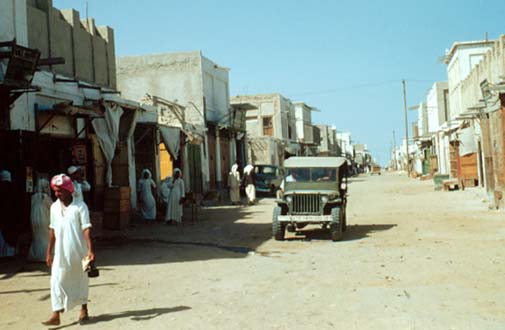 |
|||||||||||||||||||||
| Al Khobar's Main Street in 1950. This is where stores like The Green Flag and Abdallah's began the modernization process. (rcc) | |||||||||||||||||||||
| By 1982, Al Khobar sprawled so far north, one did not notice the pause when leaving Al Khobar and arriving at Dammam, the province's capital. The main street in al Khobar extended six or so additional blocks to the south and was named after a member of the royal family. There were several parallel shopping streets, and the cross streets that followed the expansion ended at the seawall which had a small corniche. Traffic was constantly snarled. In 1949 a single track marked this route and there was little guarantee one could make that journey through the sand. In 1985, several high rise apartments and hotels marked the road to Dammam; the road was paved and a British company won the contract to create a giant sanitary system for the city. The gigantic Meridien Hotel graced the seawall. | |||||||||||||||||||||
 |
|||||||||||||||||||||
| Modern dhows no longer sport the characteristic lateen-shaped sail. They are power by diesel and gasoline engines (rac) | |||||||||||||||||||||
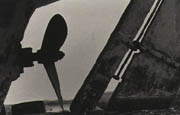 |
|||||||||||||||||||||
| Dhows now employ screws as drive mechanisms. Somehow dhows look unsightly without sails overhead. (rac) | |||||||||||||||||||||
|
In 1949, the pier was really an earth-fill tongue which stretched into the Gulf a few hundred meters. The end of the jetty was constructed securely and ARAMCO launches regularly diesel- ed off to Manama. The trip, first south along the shoreline, followed a shallow channel which turned east and then back north for the run to Bahrain. The water was absolutely pristine and the colors were exotic beyond belief. It was about a four-hour journey and the launch would pass many dhows under sail, loaded with goods or pearl divers, depending on the season. The water was aquamarine and the tropical fish were colorful and abundant. Porpoises frequently ran with the launch. Eventually, the Saudi government and the Sheik of Bahrain came to terms and a causeway now links the two countries. In 1949, we walked by the al Khobar butcher shop and saw pieces of meat buzzing black with flies. In 1985, I walked into a modern butcher shop and purchased frozen beef from Iowa (boxed beef). What a difference a few years make! Al Khobar is now affected by urban sprawl, multilane highways, and a huge hub to direct traffic in all directions. Traffic is heavy and the community is prosperous. |
|||||||||||||||||||||
|
Copyright ©1999-2006 Rolf A.
Christophersen |
|||||||||||||||||||||